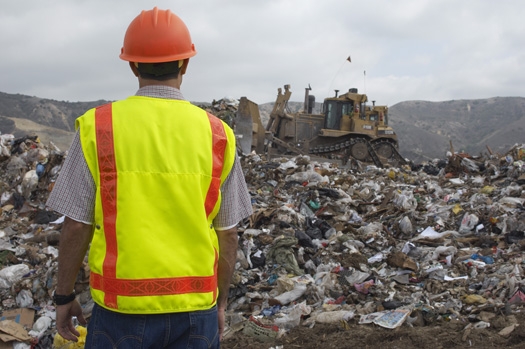We use cookies to make your experience better. To comply with the new e-Privacy directive, we need to ask for your consent to set the cookies. Learn more.
OSHA Standards for Landfill Workers
In the United States, if you work in construction, or in the maritime industry, or on a farm, the Occupational Safety and Health Administration (OSHA) gives you an entire section of the Code of Federal Regulations, Title 29, complete with its own part number. (The maritime industry gets three of them.)

The remainder of America’s workforce relies on a single section — 29 CFR 1910, Occupational Safety and Health Standards for General Industry — to enumerate an employer’s responsibility to keep workers safe under pain of fine or forfeiture.
More to the point, there are no OSHA regulations specifically written for landfill workers, let alone material recovery facilities. Employers look to 29 CFR 1910 for the rules governing safety responsibilities at their workplaces — all sorts of workplaces — and these are the standards that cover occupational safety at the landfill.
In other words, there aren’t really OSHA standards for landfill workers. But there are OSHA standards employers at landfills need to know. Here are just a few examples:
-
29 CFR 1910 Subpart I: Personal Protective Equipment
Hard hats aren’t optional for many landfill employees. According to standard 1910.135(a)(1), head protection is required “when working in areas where there is a potential for injury to the head from falling objects.” Other standards from Subpart I also apply to workers at landfills. Employers might need to provide eye and face protection, too. They almost certainly should provide employees with respirators: “A respirator shall be provided to each employee when such equipment is necessary to protect the health of such employee,” says standard 1910.134(a)(2).
-
29 CFR 1910 Subpart O: Machinery and Machine Guarding
From shredders to compactors, a lot of the equipment workers use at the landfill must include guards according to this OSHA standard. More specifically, 29 CFR 1910.212(a)(1) states that: “One or more methods of machine guarding shall be provided to protect the operator and other employees in the machine area from hazards such as those created by point of operation, ingoing nip points, rotating parts, flying chips, and sparks. Examples of guarding methods are barrier guards, two-hand tripping devices, electronic safety devices, etc.”
-
29 CFR 1910.1200: Hazard Communication
Inevitably, some wastes considered hazardous will end up at the landfill. This OSHA regulation requires labels for all hazardous chemicals in accordance with the United Nations Globally Harmonized System of Classification and Labelling of Chemicals.
Note that the above standards are only meant to serve as examples; employers at landfills and MRFs must follow the full range of OSHA’s 1910 safety regulations for general industry. When in doubt, consider the General Duty Clause of the OSH Act of 1970, the law that created OSHA and empowered the Administration to make the rules in the first place.
The General Duty Clause states that “Each employer shall furnish to … employees employment and a place of employment which are free from recognized hazards that are causing or are likely to cause death or serious physical harm to [those] employees.” The rule essentially insists that employers keep their employees as safe as they possibly can. When you find yourself in the shadow of a potential safety issue, guide your decision by the light of this proposition.
References:
“29 CFR 1010 - OSHA Standards.” OSHA. Occupational Safety and Health Administration, U.S. Department of Labor, n.d. Web. 26 Mar. 2019.
“OSHA Act of 1970 - General Duty Clause.” OSHA. Occupational Safety and Health Administration, U.S. Department of Labor, n.d. Web. 26 Mar. 2019.
